Standards Worldwide
Standards Worldwide
Phone +49 30 58885700-07

Standard [CURRENT]
ASTM D 751:2019
Standard Test Methods for Coated Fabrics
- German title
- Prüfung von beschichteten Geweben
- Publication date
- 2019
- Original language
- English
- Pages
- 20
- Publication date
- 2019
- Original language
- English
- Pages
- 20
- DOI
- https://dx.doi.org/10.1520/D0751-19
Product information on this site:
Quick delivery via download or delivery service
Buy securely with a credit card or pay upon receipt of invoice
All transactions are encrypted
Short description
1.1 These test methods cover, but are not limited to, rubber-coated fabrics, that is, tarpaulins, rainwear, and similar products. 1.2 The scope of each of these test methods appears in the section in which the test method is described. 1.3 The test methods appear in the following sections: Test Method Section Dimensions and Mass 7 - 10 Breaking Strength 11 Procedure A-Grab Test Method 12 - 15 Procedure B-Cut Strip Test Method 16 Elongation 17 Bursting Strength 18 Procedure A - Ball Burst Method 19 - 22 Procedure B - Diaphragm Burst Method 23 - 26 Puncture Resistance 27 - 30 Tearing Strength 31 Procedure A-Pendulum Method 32 Procedure B-Tongue Tear Method 33 - 36 Trapezoidal Tear 37 - 40 Hydrostatic Resistance 41 Procedure A-Mullen Type Tester 42 - 45 Procedure B-Rising Water Column Tester 46 - 49 Adhesion Coating (to Fabrics) 50 - 53 Strength of Coating 54 - 58 Tack-Tear Resistance 59 - 63 Low Temperature Bend Test 64 Low Temperature Impact Test 65 Low-Temperature Crack Resistance 66 - 70 Seam Strength 71 - 76 Accelerated Heat Aging (Oven Method) 77 - 84 Dead Load Seam Strength 85 - 88 Blocking Resistance at Elevated Temperatures 89 - 93 Crush Resistance 94 - 98 Wicking of Coated Cloth 99 - 102 1.4 The values stated in SI units are to be regarded as the standard. The values given in parentheses are for information only. 1.5 This standard does not purport to address all of the safety concerns, if any, associated with its use. It is the responsibility of the user of this standard to establish appropriate safety, health, and environmental practices and determine the applicability of regulatory limitations prior to use. 1.6 This international standard was developed in accordance with internationally recognized principles on standardization established in the Decision on Principles for the Development of International Standards, Guides and Recommendations issued by the World Trade Organization Technical Barriers to Trade (TBT) Committee.
ICS
59.080.40
DOI
https://dx.doi.org/10.1520/D0751-19
Also available in
Loading recommended items...
Loading recommended items...
Loading recommended items...
Loading recommended items...
